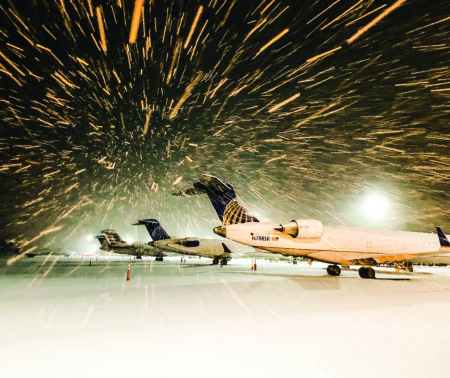Words by Steve Johnson
Aviation and the weather are inextricably connected. When conditions are good the weather is not an issue for business aviation. But those in aviation always treat the weather with guarded respect. Conditions can change quickly in some parts of the world. Being prepared is essential. Pilots, ground operations, airports and airfields therefore have an insatiable appetite to be kept informed, to understand and respond to weather forecasts.
For business aviation companies operating and working with smaller aircraft, that often means delays or diversions. Significantly, weather forecasting and information technology has progressed enormously in recent years, making the task of understanding and responding much more straightforward.
Robert Fisch, co-president of the Luxaviation Group says, “The role and responsibilities of airport management, flight planners and flight crews haven’t changed much, but the tools supporting the decision-making process have.
“Firstly, weather data is now available instantly and available in real time, from very local information around the departure airport to details for an intercontinental flight.
“Secondly, multiple sensors from multiple sources now deliver extremely precise data. Weather data collected by an aircraft is automatically transmitted to ground stations. The third factor is in the representation of weather data and the help available interpreting that data, a process greatly simplified by new technologies, including apps everyone can have on their smartphones, tablets and computers.”
Digital times

A sign of changing times was the deactivation of the Hazardous In-flight Weather Advisory Service (HIWAS) earlier this year. Although there were concerns when the plan to shut HIWAS down was initially announced in 2018, its loss has not had a significant impact.
NBAA’s director of air traffic services and infrastructure, Heidi Williams says, “NBAA participated in the FAA safety panel to ensure that the impacts were mitigated ahead of the HIWAS cancellation. The panel acknowledged that there are plenty of additional resources that are now being used by pilots and operators for both flight planning and in-flight weather resources.
“The use of HIWAS by operators significantly declined as other resources have become available.”
Digital and connected technologies have made it possible for weather information and forecasting tools to be integrated on to the flight deck or on to portable devices. With on-board wifi connectivity, weather updates can be virtually instantaneous. There is therefore a requirement to be able to manage weather situations accordingly.
John Kosak, program manager of weather air traffic services at the NBAA says, “The National Weather Service continues to improve products and create new ones. A great example of this is the new Graphical Forecast for Aviation from the Aviation Weather Center. This replaced the old, text-based Area Forecast with a much more robust graphical product.
The Graphical Forecast contains all of the same variables, such as ceilings, visibility, precipitation, winds and turbulence but is refreshed more often and with better resolution. Operators can look up to 17 hours in the future and zoom into areas of the map.
“Over the last few years, we’ve seen an increase in computing power,” adds Kosak. “The development of higher resolution models give us more timely and accurate forecasts because we’re not just feeding them with more observations, but better observations.”
Accuracy is king

As the availability of weather data has increased it has also become more accurate. Jason Plowman, senior manager of meteorology at Universal Weather and Aviation says,
“I have been in the forecasting business for more than 30 years and it has changed tremendously from the old days of hand analyzing and limited choices for weather models and satellite data.
“In the last five years the USA has launched two new satellites to replace older ones. The Global Forecast System model data has been upgraded and the Euro model continues to upgrade its data. Plus, we have many
short-range models specifically made to help with severe weather forecasting.”
The combination of better input and faster computers enables higher resolution weather models, resulting in better forecasts. Mike Cetinich senior product manager, weather and chief meteorologist from Boeing Digital Solutions and Analytics says, “As more aircraft are equipped with better instrumentation, we will get an improved profile of the atmosphere globally, which will yield a better forecast. We have more than 1,000 aircraft worldwide that are capable of providing near real-time turbulence reports, which are being used today by pilots to make better decisions for avoiding rough air in their flight paths.”
Aircraft operators are tasked with delivering a high quality, personal service to demanding clients. Whatever a client’s demands, safety will always prevail, particularly where the weather is concerned. Patrick Margetson-Rushmore, CEO, Luxaviation UK says, “Safety is always the primary driver for whether a flight should depart or not. Our operations team liaise closely with the crews, so that we can keep our clients informed. As technology improves, the ability to make informed decisions also improves. Operations staff undergo annual recurrent training in weather report analysis to ensure everyone understands the information provided and the most appropriate routing is selected.
“In some situations, our clients will make a decision to delay for their own inflight comfort or in conjunction with the crew a flight may have to be delayed anyway, due to strong wind speeds or cross winds at an angle outside the aircraft’s operating limits. In some cases, flights are rescheduled to alternative nearby airports where runway direction for example, is better in relation to the wind direction and speed.”
Often, the best tactic for operators is only to travel when the weather is of no concern. Weather-related operational constraints can be accounted for in flight planning, removing the need to descend into storms. Fisch says, “As a pilot, if you find a thunderstorm sitting on top of your destination airport, you need to apply lessons learnt when training and consider the options – from flying to an alternative location to just waiting. After all, most summer thunderstorms are only intense for a short time. The weather moves from one extreme to the other in minutes.”
Improvements in weather forecasting technology and connectivity are also helping the aviation workforce develop skills and experience in dealing with challenging weather conditions. The latest generation of systems and tools can help less-experienced pilots learn faster and benefit from transfer of knowledge. Cetinich says, “Better training is becoming available through webinars, podcasts and social media mechanisms.”
Moreover, with the advancements in weather forecasting technology in all its forms, there will be new career opportunities in aviation and meteorology.
Plowman says, “I would very much like to see the younger generation get more involved in both aviation and meteorology. We need more people interested in the subject. The opportunities are out there and should be taken advantage of because it is a win for all of us in aviation.”





